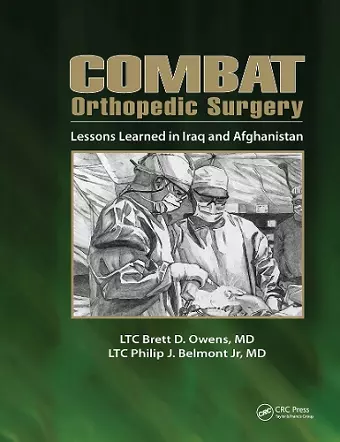Combat Orthopedic Surgery
Lessons Learned in Irag and Afghanistan
Brett Owens author Philip Belmont author
Format:Hardback
Publisher:Taylor & Francis Inc
Published:15th Feb '11
Currently unavailable, and unfortunately no date known when it will be back

During the course of the Iraq and Afghanistan Wars, military orthopedic surgeons have made significant technical and philosophic changes in the treatment of musculoskeletal combat casualties. The widespread use of individual and vehicular body armor, evolution of enemy tactics to include its reliance on improvised explosive devices, and the effectiveness of treatment rendered at military treatment facilities have resulted in a large burden of complex orthopedic injuries. Combat Orthopedic Surgery: Lessons Learned in Iraq and Afghanistan represents and recognizes the latest advances in musculoskeletal surgical care performed to treat today's US military servicemembers.
Editors LTC Brett D. Owens, MD and LTC Philip J. Belmont Jr., MD have brought together the leading military orthopedic surgeons to relay their clinical orthopedic surgery expertise, as well as to discuss how to provide optimal care for combat casualties both initially in theater and definitively at tertiary care facilities within the United States.
Combat Orthopedic Surgery: Lessons Learned in Iraq and Afghanistan is divided into five sections, with the first being devoted to an overview of general topics. The second section covers scientific topics and their clinical application to musculoskeletal combat casualties. The final three sections are clinically focused on the upper extremity, lower extremity, and spine and pelvic injuries, with many illustrative case examples referenced throughout.
Most clinical chapters contain:
- Introduction/historical background
- Epidemiology
- Management in theater
- Definitive management
- Surgical techniques
- Outcomes
- Complications
Combat Orthopedic Surgery: Lessons Learned in Iraq and Afghanistan will be the definitive academic record that represents how orthopedic surgeons currently manage and treat musculoskeletal combat casualties.
“The new textbook "Combat Orthopedic Surgery" should be mandatory reading for all those who care for injured combatants. The authors have assembled an excellent group of highly experienced physicians, describing management based on various body regions or systemic pathology. It is the definitive reference book for optimal treatment of orthopaedic injuries from the ongoing war in Iraq and Afghanistan. I will place this book on my shelf and use it often.”
-- John Holcomb, MD, FACS, Chief of the Division of Acute Care Surgery, Director of the Center for Translational Injury Research at the University of Texas Health Science Center; former commander of the U.S. Army Institute of Surgical Research
“Good textbooks on surgical technique are indeed precious. They provide thoughtful commentary on a host of subjects that range from systems of care to operative planning to recovery. When done well, they are written by experienced clinicians and include high quality radiographs, summary tables and operative photographs that help guide younger clinicians when they are faced with difficult management problems. This book is one of the truly good examples of what these textbooks should be.
Advances in injury care almost always come around times of armed conflict. While some of these occur in the civilian sector, most of them are military, and this occurs virtually every time a war is fought. Unfortunately, the battlefield is an example of one of the least controlled environments in which clinicians work. It is difficult to catalogue radiographs and even more difficult to obtain good operative photos. Finally, follow up care can be fragmented, making the ability to follow a single patient from injury to recovery extraordinarily difficult.
This book addresses all of these issues and does so nearly flawlessly. It covers all of the important areas of soft tissue and bony injury. The book begins with a discussion of principles of orthopedic care and then describes the echelons of care available in the current conflict. It goes on to discuss other clinically relevant topics such as infection and then divides the body into anatomic zones and reviews the principle of care for each one.
The text is concise but complete. The radiographs and operative photos are superb. The authors are clearly very experienced. This book is a must read for any young surgeon who is interested in a comprehensive view of battlefield bony injuries. Many of the principles will be pertinent for high energy civilian injuries as well. The authors should be commended for a wonderful job and have provided us all with a meaningful resource.”
-- Thomas M. Scalea, MD, Francis X. Kelly Professor of Trauma Surgery; Director, Program in Trauma; Physician-in-Chief, R Adams Cowley Shock Trauma Center
"This book is unique in its field, providing complete and detailed information on the management of the type of orthopedic surgical injuries sustained in Iraq and Afghanistan Wars. The authors are to be commended. I find myself humbled."
— Samuel J. Chmell, MD, University of Illinois at Chicago College of Medicine, Doody’s Enterprises, Inc.
ISBN: 9781556429651
Dimensions: unknown
Weight: 1406g
350 pages